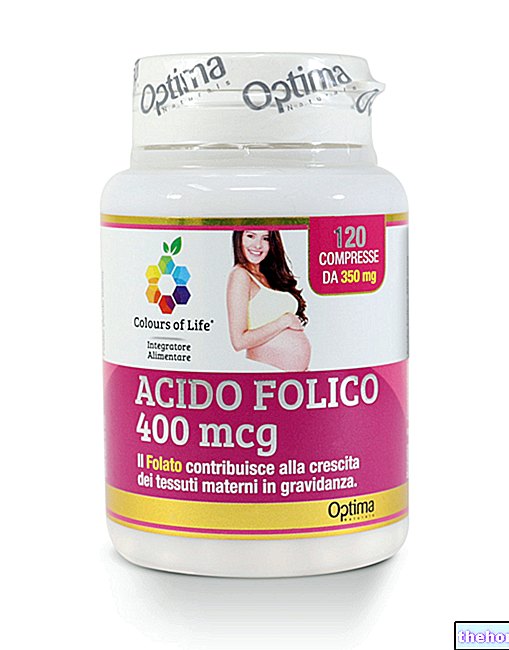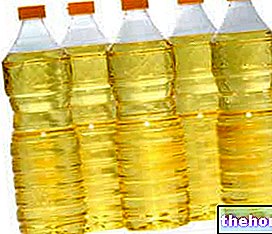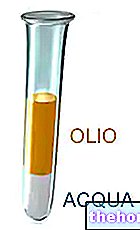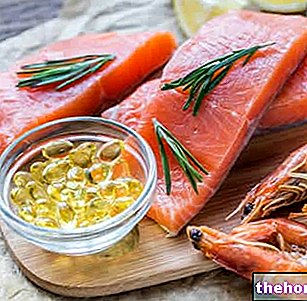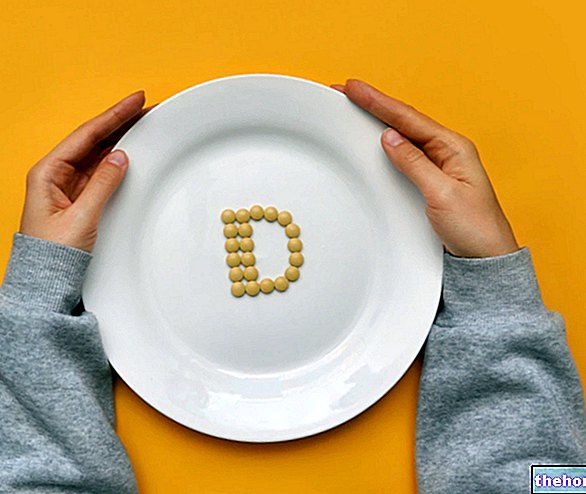" first part
Unsaturated fatty acids
With the general formula CnHnCOOH, they have one or more double carbon bonds that allow them to react with other elements.
Unsaturated fatty acids tend to decrease cholesterol and LDL lipoprotein levels in the blood, disfavoring the atherosclerotic process; oleic acid, contained above all in olive oil, can favor a modest increase in good HDL cholesterol, especially if associated with regular physical activity and a sober and balanced diet. Some polyunsaturated fatty acids are essential nutrients because they cannot be synthesized by mammals.
Unsaturated fatty acids are contained in lipids of vegetable origin, mostly liquid at room temperature and in fish, while saturated fatty acids are present in products of animal origin and in seasoning fats (butter, lard, margarine, etc.) .
The main monounsaturated fatty acids
Number of atoms
carbon
The fatty acids highlighted in bold are the most important from a nutritional point of view.
Polyunsaturated fatty acids
Polyunsaturated fatty acids have more than one double bond (-C = C-).
Num. Atoms
by C
cis, cis-9.12-
octadecadienoic
18
CH3CH2 (CH = CHCH2) 3 (CH2) 6COOH
cis, cis, cis-9,12,15-
octadecatrienoico
cis, cis, cis, 6-9.12, -
octadecatrienoico
cis, cis, cis, 4-
8,12,15-
octadecatetraenoic
cis, cis-13.16-
docosadienoic
cis, cis, cis, cis-
5,8,12,15-
eicosatetraenoic
Eicosapentaenoic
(EPA)
22
Docosahexaenoic
(DHA)
C22: 6
cis, cis, cis, cis-
4,8,12,15-
eicosapentenoic

B.C. Oleic (18: 1; 9)
B.C. Linoleic (18: 2; 9.12)
B.C. γ-Linolenic (18: 3; 6,9,12)
PLEASE NOTE: "γ-Linolenic acid does not belong to the omega three series, but to the omega 6 series; for this reason, supplements based on ω3 essential fatty acids must contain" α-Linolenic acid "and not" γ-Linolenic acid "
Essential fatty acids
The term "essential fatty acids" (EFAs) can be confusing. In fact, the "essential adjective can be interpreted in two different ways:
extended "What is essential for the life of the subject";
Restricted "What must necessarily be taken with" nutrition because our body is unable to produce it. "
Essential fatty acids are essential for regulating:
- growth
- energy production
- cell membrane and mitochondrial membrane health
- the synthesis of hemoglobin, coagulation and capillary fragility
- sexual function and reproduction (some breast diseases and alterations in the menstrual cycle derive from an "excessive intake of saturated acids in relation to omega 3 / omega 6)
- some skin conditions (atopic eczema and dermatitis)
- improved carbohydrate tolerance in diabetics
- a reduction (omega 3) in total cholesterol, bad cholesterol (LDL) and triglycerides
- as precursors of prostaglandins.
Omega-6 polyunsaturated fatty acids lower cholesterol, reducing plasma LDL levels. This benefit, however, is mitigated in part by the fact that the same omega-6 fatty acids also reduce the "good" HDL cholesterol.
Good sources of omega-6 are seed oils, nuts and legumes.
Omega-3 polyunsaturated fatty acids lower plasma triglyceride levels by interfering with their incorporation into the liver into VLDLs. For this reason they possess an "important antithrombotic action (remember, in fact, that high levels of triglycerides in the blood reduce the process of fibrinolysis, responsible for the dissolution of intravasal clots; for this reason" hypertriglyceridemia is accompanied by an increased risk of cardiovascular diseases) .
The best food sources of omega-3s are cold sea fish, oil and flax seeds.
The glycerides
They represent 98% of dietary lipids and those present in the human body. Fatty acids bind to glycerol, a molecule with three alcoholic functionalities, therefore capable of binding to itself three molecules of fatty acid; if one binds, 1-monoacylglycerol or 2-monoacylglycerol is obtained; if two are bound, 2-monoacylglycerol or 1,3-diacylglycerol is obtained.

In most cases, glycerol binds to itself not one, not two, but three fatty acids, thus giving rise to triacylglycerols, better known as triglycerides.
They are defined simple, those triglycerides in which the three fatty acids are equal to each other. Otherwise we are talking about mixed triglycerides.
The melting point of a triglyceride is higher the lower the number of double bonds and the greater the length of the aliphatic chains of the fatty acids that compose it.
Monoacylglycerols and diacylglycerols result from incomplete synthesis or degradation of the triglyceride; in the food industry they are used as emulsifying additives or thickeners.
The phospholipids
They are divided into phosphoglycerides, in which an OH of glycerol is esterified by phosphoric acid, and sphingolipids, in which fatty acids are linked to an unsaturated amino alcohol (sphingosine). In reality, in sphingolipids there is no phosphoric group, for which some authors they classify them in a separate category.
Phosphoglycerides are glycerol molecules in which two adjacent OH are esterified with two fatty acids, while the third hydroxyl group binds with phosphoric acid. The simpler phospholipid is called phosphatidic acid. In the other phosphoglycerides other molecules bind to phosphoric acid (for example, if choline is binded, phosphatidylcholine, better known as lecithin, is obtained).
They are synthesized inside cells, in particular in the liver. Due to their greater solubility they facilitate the transport of other fats, but their main task is to form cell membranes. Phospholipids therefore have a "high biological importance, but are scarcely present in food. Sold as food supplements (soy lecithin), they are useful for keeping blood cholesterol levels under control and have restorative properties.

In sphingolipids, fatty acid binds to a molecule called sphingosine with an amide type bond. Other molecules such as choline (sphingomyelin is obtained), glucose (glucoerebroside) or galactose (galactocerebroside) can also bind to sphingosine. The latter two are classified as sphingoglycolipids.
Glycolipids, waxes and sterides
They can be classified into:
- SPHINGOGLYCOLIPIDS: glucocerebrosides and galactocerebrosides
- GLYCOSYLDIACYLYCEROLS: they are 1,2 diacylglycerols in which a sugar, generally glucose, is bound to the free hydroxyl of glycerol. Therefore, while in phosphoglycerides the third OH is bound to phosphoric acid, in glycosylacylglycerols the third OH is bound to a sugar
The saponifiable lipids also include waxes and sterides. Waxes are esters of a fatty acid with a long-chain alcohol, while sterides are esters of sterols with a fatty acid (for example, the cholesterol ester with a fatty acid, such as palmitic or oleic, falls within the category of sterides).
Waxes are extremely insoluble in water and chemically inert. These characteristics give it particular protective functions (prevent the excessive loss of liquids and the penetration of pathogens), which they perform by layering on the epidermis or on the exposed surfaces of the leaves.
Non saponifiable lipids
Most are steroids, molecules with a basic structure called cyclopentanperhydrophenanthrene. In the animal field there is only one sterol, cholesterol, while in the plant world there is an "abundance of phytosterols (or plant sterols). Among the most important are Β-systosterol, its glycosylated compound, stigmasterol and campesterol.
Ergosterol is not really a phytosterol, since it is typical of fungi that belong to a kingdom apart from the animal and vegetable kingdoms.
Each oil has its own typical sterol composition. Although these molecules represent only 1% of the total lipids, the phytosterol composition is comparable to the oil fingerprint and allows to recognize any adulterations or food adulterations.
The non saponifiable lipids also include terpenes, substances consisting of one or more units of isoprenoids. They give rise to many different compounds, such as the terpenic ones (at the base of aromas and essential oils), squalene (component of olive oil), beta-carotene and lycopene.

